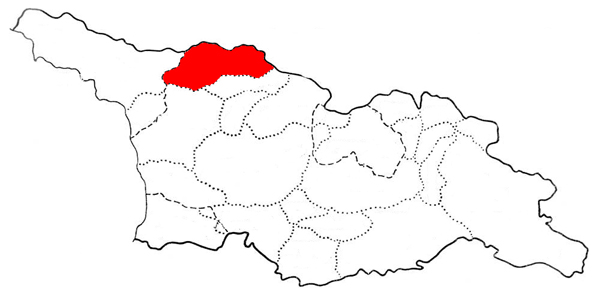|
Ushguli Church Of The Mother Of God
The Ushguli Church of the Mother of God, popularly known as the Lamaria Church, is a medieval Georgian Orthodox church in the community of Ushguli in Upper Svaneti. It is a simple hall church, with a projecting apse and an ambulatory. The interior contains two layers of medieval frescoes, in a state of deterioration. The church is inscribed on the list of the Immovable Cultural Monuments of National Significance of Georgia. Location The Lamaria church is situated on the northern outskirts of the highland village of Zhibiani, a constituent village of Ushguli, in Mestia Municipality. Zhibiani is one of the highest permanently inhabited places in Europe, located at 2,100 above sea level. The building tops a hill above the village, set against the backdrop of the 5,201 metre-high Shkhara peak of the Greater Caucasus range and the highest point in Georgia (country), Georgia. The church is surrounded by a low stone wall and defended by a Svan towers, Svan tower standing on its west en ... [...More Info...] [...Related Items...] OR: [Wikipedia] [Google] [Baidu] |
Ushguli
Ushguli ( ka, უშგული ) is a community of five medieval villages located at the head of the Enguri gorge in Svaneti, Georgia. Ushguli is one of the highest continuously inhabited settlements in Europe. Compared to somewhat more developed towns like Mestia, Ushguli is not in an accessible location, which has preserved many of the villages' medieval characteristics, including unique defensive tower houses called Svan towers. Anthony Bourdain: Parts Unknown9 reasons to visit Georgia now CNN, 17 May 2016 Because of their preservation and traditional architecture, Ushguli, Mestia, and the surrounding area was recognized as the ''Upper Svaneti'' UNESCO World Heritage Site in 1996. Location and features Ushguli is located at an altitude of near the foot of Shkhara, one of the highest summits of the Greater Caucasus mountains. About 70 families (about 200 people) live in the area, enough to support a small school. The area is snow-covered for 6 months of the year, and oft ... [...More Info...] [...Related Items...] OR: [Wikipedia] [Google] [Baidu] |
Lamaria – Ushguli – 04
Lamaria (also Lamara or Lamia; ) is a goddess in Georgian mythology, specifically of the Svan ethnic subgroup. Like many other deities of the Svan pantheon, her name is derived from a Christian figure; in her case, Mary, mother of Jesus. Lamaria is the goddess of the hearth, protector of cattle, and a protector of women – particularly during childbirth. She also ensured the fertility of a village's grain fields. She was also known as a patron of beekeeping, although that function was later assigned to the Svan interpretation of St. George. Lamaria is generally categorized today as a goddess of female functions and spaces. She was venerated by women either inside their homes in the absence of men (the "interior of the interior"), or in small shrines in uninhabited spaces outside a village's boundaries (the "exterior of the exterior"). This was in contrast to religious rituals performed by men for male functions, which were either performed at public rituals inside the home, or wi ... [...More Info...] [...Related Items...] OR: [Wikipedia] [Google] [Baidu] |
